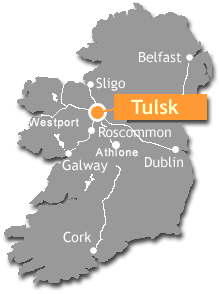Rathbeg or An Ráth Beag, the Small Fort, provide a confused notion as to the function of this monument. The name was first recorded in the late 19th-century by the Irish language scholar John O'Donovan as part of the Ordnance Survey of Ireland.
 |
| Rathbeg from the roadside (Image courtesy of Rathcroghan Visitor Centre) |
Despite the name denoting a place of residence,
Rath translating to Fort, the site has been identified as a ring-barrow. It is located approximately 540 metres North West of Rathcroghan Mound. The monument is situated on a high knoll on the South West end of a small ridge. The monument composes a small central cairn which is surrounded by a pair of concentric banks with inner ditches cut on the perimeter of the knoll. The placement of the ditches inside the banks suggests the possibility of this monument not having an overly defensive function. The inversion of this system on monuments is sometimes suggested to indicate ritual or ceremonial activity. The overall diameter of the feature is approximately 36 metres.
 |
| 3D LiDAR model of Rathbeg (Image courtesy of OSi & Kevin Barton) |
A barrow, or tumulus, is almost exclusively associated with single or multiple burials. There are a wide range of different types of barrows whose names usually derive from their individual shape. Such monuments tend to originate in the Neolithic and Bronze Age in Ireland. There is plenty of evidence for later interactions and reinterpretations by successive generations which has, in turn, preserved their ritual importance but oftentimes changing the original role. This can be seen through the reuse of such monuments at the sites of Tara, Navan Fort and our own Rathcroghan.
 |
| Rathbeg: combination model of annotated shaded relief model draped over a 3D LiDAR model in the previous image |
The literature concerned with Cruachan presents a context for a number of the archaeological features on the complex. Burial mounds and tumuli, such as Rathbeg, legitimise recorded references to Cruachan. This pertains to the description of the site as one of the three Heathen Cemeteries of Ireland by Christian scribes in the 12th-century manuscript Lebor na hUidre or The Book of the Dun Cow.
There appears to be a certain correlation between the positions of the mounds of Rathbeg and Rathcroghan. Observations at the summit of either will grant clear, unobstructed views to the other. Therefore, Rathbeg's location lends itself to many theories regarding its ritual purpose and status of the presumed corpses deposited at the mound. Although these questions can only be answered through excavation, there is a tantalising possibility that a member or members of the Iron Age
Aos Dána or high-status warrior caste could be interred
in situ. Its central proximity in relation to both Rathmore and Rathnadarve may also suggest the feasibility of interaction between these features in some ritual or ceremonial capacity. Daniel Curley
 |
| Rathbeg can be seen to the south of the N5 |







No comments:
Post a Comment